|
Das Athame von Galen |
|
|
|
Das Athame von Galen |
|
|
Bevor "Wicca" das Licht der Welt erblickte, spielte das Ritualmesser mit dem dunklen bzw. schwarzen Griff eine eher untergeordnete Rolle in der magischen Welt. Erst durch Gerald B. Gardner wurde das Ritualmesser zum "Standardwerkzeug" einer jeden Hexe, aber auch magisch arbeitenden Heiden.
| Gardner war schon immer von Messern fasziniert. Im Januar 1936 veröffentlichte er sein erstes Buch "Keris and other Malay Weapons" (Progressive Publishing Compagny, Singapur / wieder veröffentlicht 1973 und 2002 von Orchid Press, Thailand). Auf 138 Seiten werden malaysische Waffen beschrieben, wobei das Keris (ein malaysischer Dolch) den Hauptteil ausmacht. | 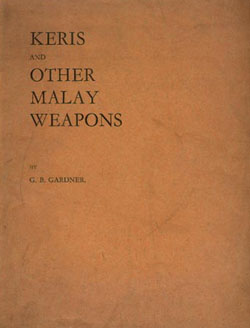 |
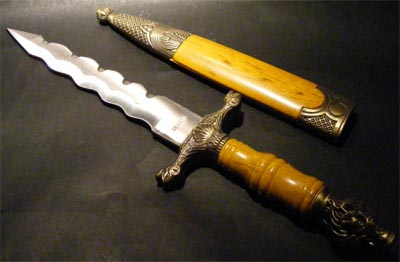
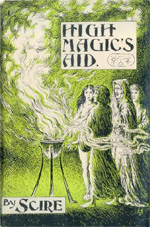
Original von 1949
Release 1975 (Weisser)
Release 1996
Release 1999 (I-H-O) |
Das Wort "Athame" als Bezeichnung für das
Ritualmesser mit dem dunklen Griff gab es vor Gardner nicht. Erstmals tauchte es
in Gardners drittem Buch "High Magic's Aid" aus dem Jahr 1949 (Atlantis
Bookshop, London, Herausgeber: Michael Houghton) auf:
auf Seite 3: "To make the sword I need the burin, to make the burin I must have the consecrated white-hilted knife, the witch's athame." auf Seite 19: "We needed the witch's athame to fashion our tools,. so we went to the sabbath to try to borrow one ..." auf Seite 92: "Morven
stood there, her body rosy scented and vibrant from water and hard rubbing,
holding a knife in each hand, the black-hilted
athame and that with the white handle." ... auf Seite 96: "He purified it on the live coals and, with the white-handled knife, whose office was that of a tool as distinct from that of the athame used, by the witch to control spirits and work magic, he carved on the handle of the awl, which was to become the burin, these characters:" auf Seite 98: " 'Seek ye the Witch of Wanda,' had provided him with the athame and the white-handled knife, the means to the ends they desired." auf Seite 99: "She, holding her athame in her right hand, brought the point down upon the sword's blade and held it there to communicate increased power, while Thur cried in a strong voice: "I conjure thee, O sword, by the names Abrahach, Abroath, Abracadabra, Yod He Vau He, that thou serve me for a strength and a defence in all my magical operations against all my enemies, visible and invisible." auf Seite 138: "Morven understood, and slipped out of her boy's clothes, and drew her athame." auf Seite 139: "With
solemn steps she paced to its edge, holding her precious athame
erect in her right hand."
... auf Seite 142: "She stepped backwards, keeping her right hand with the athame raised above her head, her left hand outstretched." Seite 159:
"Upon the altar lay the athame,
the magic sword, the burin and the sprinkler, also materials for their
work: four iron disks, two-and-a-half inches in diameter, already purified
by fire, had been prepared previously." ... auf Seite 161: "Morven took her athame, and while they held the points of their weapons on the first pentacle, Thur recited slowly and with the utmost intensity he could summon:" auf Seite 162: "Morven with a gesture, she held her athame above it; while he held his sword in a like manner, he conjured it; saying: By all the powers and rites, I conjure thee, render this pentacle irresistible, O Lord Adonai." auf Seite 167: "After a moment of silence he spoke again. "Jan and Olaf, you will need your swords; Morven hath her athame." auf Seite 168: "In her right hand she held her athame, and she slung the handle of the basket on her arm." auf Seite 181: "She and Jan mounted to the loft, here she re-drew the circle with her athame, leaving a doorway, then circumambulated three times sunwise, with a dancing step, as she did so calling on the mighty ones of the east, south, west and north to attend, then after dancing around several times in silence, she chanted;" auf Seite 182: "Then,
placing the point of her athame
to his heart said: O thou
who standest on the threshold between the
pleasant land of men and the domains of the dread lords of the outer
spaces, hast thou the courage to make the assay?"
... auf Seite 182: "With
this as with the athame,
thou canst form all magic circles, dominate,
subdue and punish all rebellious spirits and demons, and even persuade
the angels and genii."
... auf Seite 188: "Then
she prompted him to do the same with the athame,
another kiss."
... |

| In Gardners Bibliothek befand sich eine Ausgabe
von S. L. MacGregor Mathers "The Key of Solomon" (George Redway,
London, 1888). In Book II - Chapter VIII, Seite 96 steht:
"Of the Knife, Sword, Sickle, Poniard, Dagger, Lance, Wand, Staff, and other Instruments of Magical Art. ...But as for the Knife with the black hilt (see Figure 62) for making the Circle, wherewith to strike terror and fear into the Spirits, it should be made in the same manner, except that it should be done in the day and hour of Saturn, and dipped in the blood of a black cat and in the juice of hemlock, the Characters and Names shown in Figure 62 being written thereon, from the point towards the hilt. Which being completed, thou shalt wrap it in a black silk cloth." |
 |
Allein im British Museum in London gibt es sieben verschiedene Abschriften des "Key of Solomon" (Clavicula Salomonis) (ich persönlich habe dort vier gesehen), das Wort "Athame" taucht jedoch in keiner Einzigen auf. Mathers Übersetzung basiert auf allen sieben Abschriften, überwiegend jedoch auf dem lateinischen Manuskript MS Add. 10862, das er auf Ende des 16. Jahrhunderts datiert. Das britische Museum selbst datiert MS Add. 10862 auf das 17. Jahrhundert.
Nur in einem der sieben Manuskripte wird das Messer mit dem schwarzen Griff als "arclavo" bzw. "arclavum" bezeichnet (Additional MS 10862, fos. 12V und 13V) (vgl. auch Ronald Hutton - Triumph of the Moon, Oxford University Press 1999, Seite 230).
Laut Ronald Hutton (s. o.) existiert im British Museum noch eine achte Abschrift, in dem es als "arthanus" bzw. "artamus" bezeichnet wird (Sloane MS 3847, fos 48-50)
In anderen lateinischen und italienischen Abschriften wird eine Art Sichelmesser, das zum Spitzen von Stiften benutzt werden soll, als "Artavus" bezeichnet, in anderen französischen Abschriften als "Artave".
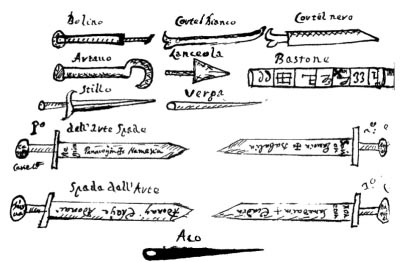
| C.J.S. Thompson (1862-1943) verwendet in seinem
Buch "The Mysteries and Secrets of Magic" (John Lane The Bodley Head Ltd.,
London 1927) die Manuskripte aus der British Library. Auf Seite 237
schreibt er:
"Then make a dassel of vervain, fennel, valerian, sage, mint, marjoram, basil and bind all these herbs in a rod of hazel that must be cut off at one cut with Arthana (the knife), and cause to be sung over it. ... ...Afterwards mark the pen with Arthana and fumigate and sprinkle with water, put him in silk cloth and write on it with a needle..." Hierbei dürfte das Messer mit dem weißen Griff gemeint sein, da es zum Schneiden verwendet wird. |
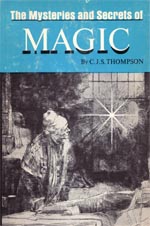 |
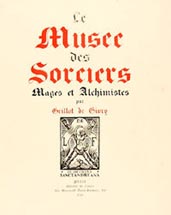 |
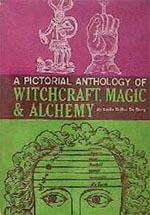 |
Die wichtigste Quelle (die später auch Clark Ashton Smith verwendete - siehe weiter unten) befindet sich in der "Bibliothèque de L'Arsenal" (mittlerweile in die "Bibliothèque de Nationale" eingegliedert) in Paris. Es handelt sich dabei um eine französische Abschrift des Clavicula Salomonis aus dem 18. Jahrhundert (die erste gedruckte Version des Clavicula Salomonis erschien übrigens 1629 in Rom), in der das Messer mit dem schwarzen Griff zum Kreisziehen als "arthame" bezeichnet wird (MS 2350 - "Le Secret des secrets, autrement la Clavicula de Salomon ou le véritable Grimoire" aus der Sammlung von Antoine René de Voyer d'Argenson, Marquis de Paulmy). Diese Abschrift ist meines Wissens die Einzige, in der das Wort "arthame" auftaucht. Die Kopie eines Bildes (im Original auf Seite 30) dieses Manuskripts befindet sich u. a. in "Le Musee des Sorciers, Mages et Alchimistes" von Emile Grillot de Givry (1874-1929) aus dem Jahr 1929 (englische Übersetzung: "A Pictorial Anthology of Witchcraft, Magic & Alchemy", 1931) als Abbildung 74 auf Seite 104: |
|
Emile Grillot de Givry - "A Pictorial Anthology of Witchcraft, Magic & Alchemy", 1931: Seite 103: "There is also a description of the essential clothing and footgear, of the knife or arthame, of the needle, or burin, the ring, the sceptre, the fire, the Holy Water, the lights, the perfumes, the virgin parchment and the pen, and of the ink and blood to write with; all these instruments are indespensable to the operation, for the evocation of a demonis not so easy a business as some idle and curious amateurs might suppose." Seite 104: "The circle must be nine feet in diameter: this space is ample for comfortable room. It must be traced with the arthame, or consecrated knife, and, says the manuscript, 'thou shalt make four Pentacles with the names of the Creator, and beyond these two circles though shalt make a circle within a square by means of the said arthame, as the circle here drawn will show and demonstrate to thee'."
|
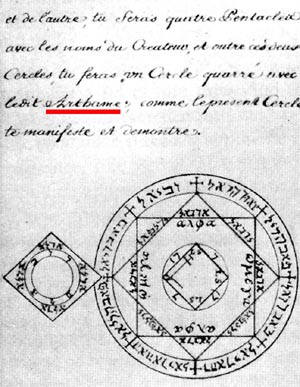
Abbildung 74 (Seite 104) |
Weder in den Schriften von Aleister Crowley, noch im Golden Dawn finden sich irgendwelche Hinweise auf ein "Athame", hier werden lediglich "Sword" (Schwert) und "Dagger" (Dolch) verwendet.
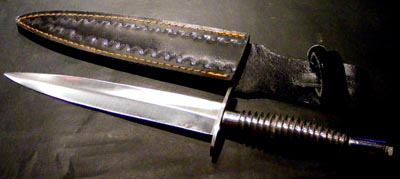
| Idries Shah, ein Sufi-Meister und enger Freund
Gardners schreibt in seinem Buch "Die Sufis" (veröffentlicht
1964, Diederichs Gelbe Reihe) auf Seite 187 (Ausgabe 1980):
"Das rituelle Messer, geheimnisvoll »Athame« genannt. Abgeleitet von adhdba-me, Instrument für den Aderlaß. »Athame« ist eine gute Annäherung an den Klang des Wortes adh-dhame."
|
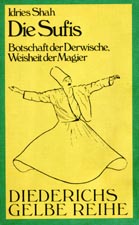 |
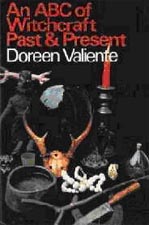
|
Doreen Valiente schreibt in "An ABC of
Witchcraft" (1973, Phoenix Publishing) auf Seiten 23+24:
"Athame. The black-hilted knife that is the traditional witches' weapon. It is used for drawing the magic circle and for controlling and banishing spirits." ... ..."An engrraved gem from ancient Rome shows Hecate, the goddess of witchcraft, in triple form. Her three pairs of arms bear the symbols of a burning torch, a scourge, and a magical dagger; once again this appears to be a prototype of the Athame."... ..."An early edition of the grimoire called the Clavicle of Solomon, dated 1572 and now in the British Museum, mentions the magical knife by the name Arthana."
|
|
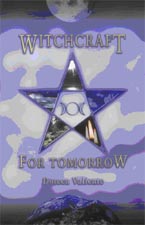 |
und in "Witchcraft for Tomorrow" (1978,
Phoenix Publishing) in Kapitel 6 "Witch Tools" auf Seite
78:
"The typical weapon of Witchcraft is the athame, or ritual knife (pronounced ath-ay-me). Old books of magic give several variations of this word, such as 'arthany', 'arthame', and so on. Clark Ashton Smith introduces it as a tool of magic, with the spelling "arthame", into one of his eerie fantasies, 'The Master of the Crabs', first published in 1947 in that classic source of such genre, the American magazine 'Weird Tales'. The origin of the word is at present unknown, though some present-day exponents of the near-eastern cult such as Sufism have attributed it to the Arabic adh-dhame, meaning 'blood-letter'. in the sense of being it a shedder of blood, which is just what the witches' athame is not. Hence this derivation does not seem very convincing."
|
Clark Ashton Smith (geb. 13.01.1903 in Long Valley, Kalifornien, USA, gest. 14.08.1961 in Auburn, Kalifornien, USA) war ein amerikanischer Science Fiction und Dark Fantasy-Autor, der eng mit H.P. Lovecraft und Robert E. Howard befreundet war. Seine Kurzgeschichten wurden u. a. in den Magazinen "Strange Tales" und "Weird Tales" veröffentlicht. Im August 1947 vollendete er seine Kurzgeschichte "The Master of the Crabs", die dann in der März-Ausgabe 1948 von "Weird Tales" veröffentlicht wurde. Smith verwendete in seinen Geschichten Begriffe aus "Witchcraft, Magic & Alchemy" von Emile Grillot de Givry, das er in seinem Besitz hatte. Die Geschichte handelt von zwei Zauberern, die im Wettstreit um einen Schatz auf einer entfernten Insel stehen. In der Kurzgeschichte sind folgende Zeilen zu lesen (Seitenzahlen beziehen sich auf die Ausgabe vom März 1948, in der die Kurzgeschichte auf den Seiten 64-71 abgedruckt ist):
| Seite 65: ...I knew that I should not sleep again that night:
for the Master wore his one-horned hat, and his cloak was girdled tightly
about him, with the ancient arthame
depending from the girdle in its shagreen sheath that time and the hands
of many magicians had blackened. ...
Seite 68: ...Taking his arthame from its sheath the Master wiped it dry with the hem of his cloak, bidding me do likewise with my own weapon lest the brine corrode it. ... Seite 69: ...With hands tightening on the hilts of our arthames, we went cautiously and circumspectly toward the cavern and paused a little short of its entrance. ... Seite 70: ...Aye, and your neophyte is also armed with an arthame. ... Seite 71: ...I stooped over, striking and thrusting with my
arthame; but the
few that I crushed in this manner were replaced by scores; while others,
catching the hem of my cloak, began to climb it from behind and weigh it
down. ... |
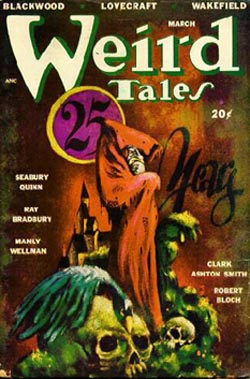 |
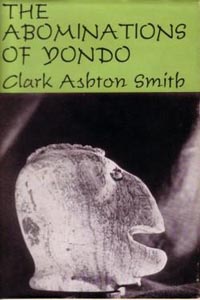 |
Die Kurzgeschichte "The Master of the Crabs" wurde dann später in der vierten Sammlung der Clark Ashton Smith Kurzgeschichten mit dem Titel "The Abominations of Yondo" von Arkham House 1960 herausgegeben (Reprints 1972 Neville Spearman, Jersey, UK und 1974 Panther Books, St. Albans, UK). |
Aber wie kommt ein Engländer an ein amerikanisches Groschenheft?
Im Spätsommer 1947 besuchte Gerald Gardner seine Verwandten in Memphis, Tennessee, USA und schiffte in New York im März 1948 zu seiner Rückfahrt nach England ein, also genau in dem Monat, in dem die Ausgabe von Weird Tales veröffentlicht wurde, in der "Master Of The Crabs" enthalten war. Es ist daher sehr wahrscheinlich, dass sich Gardner "Weird Tales" direkt in den USA kaufte, vermutlich als Reiselektüre.
Auf jeden Fall besaß Monique Wilson (Gardners letzte Hohepriesterin) die Ausgabe dieses Magazins aus Gardners Nachlass. Sie ist seit 1979 im Besitz des Silver Crescent, jetzt Blue Moon Covens. Zwar befand sich das Buch von C.J.S. Thompson in Gardners Büchersammlung, nicht jedoch das Buch von Grillot de Givry. Darüber hinaus wurde im "Book of Shadows" 1964 von Monique Wilson folgender Vermerk zum Athame angebracht: "Master of Crabs".
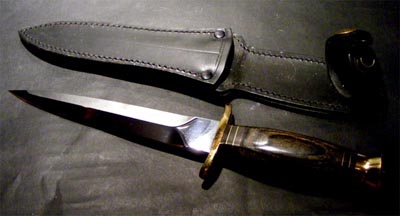
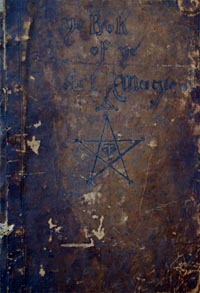 |
Gardner verwendete das Wort "Athame" in Anlehnung an Smiths "Arthame" in seinem Roman "High Magic's Aid" zunächst als fiktiven Namen für das Ritualmesser mit dem schwarzen Griff. Offenbar gefiel ihm das Wort so gut, dass er es in seine Religion "Wica" einbaute. Dies wird deutlich, wenn man sich die Urversion des Book of Shadows, dem "ye Bok of ye Art Magical", aus dem Jahr 1949 anschaut. Im Kapitel "Magical Knives" schreibt er (nach der Abhandlung über das "knife with a white hilt"): "But for the knive with the black
hilt. Erst in einem (zeitlich) späteren Kapitel ("The Circle") taucht das Wort "Athame" erstmals auf: "Having chosen a place proper, take the Sickle or Semitar of Art or a Witches Athame, if thou mayest obtain it, and stick it into the centre, ..." |
In "Witchcraft Today" auf Seite 152 (veröffentlicht 1954, Rider & Co. London) schreibt Gardner im Kapitel "Recapitulation - The Witch's Tools": "Of course, the average witch does not have a full battery of tools; not all have the sword, for instance. An Athame (witch's knife), a censer, some cord and one or two other tools are quite enough to work with. For initiations the whole battery of tools has, of course, to be present; but these usually belong to the coven."
Die deutsche Übersetzung in "Ursprung und Wirklichkeit der Hexen" (veröffentlicht 1965, Otto Wilhelm Barth-Verlag) auf Seite 145 (Kapitel XIII. Rückblick - Kultgegenstände) lautet: "Im allgemeinen besitzt eine Hexe nicht alle Kultgegenstände. Ein Athame (Hexenmesser), ein Weihrauchgefäß, ein Gürtel und noch der eine oder andere Gegenstand genügen." |
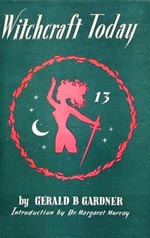
|
In anderen magischen Traditionen spielte das Athame ein untergeordnete Rolle. Erst durch Gardners "Book of Shadows" erhielt das "Athame", also das Messer mit dem schwarzen Griff, den Status des wichtigsten Ritualwerkzeugs:
"This is the true Witch's weapon, and has all the powers of the Magic Sword." (Text A + Book of Shadows 1953: First Degree Initiation - Presentation of the Tools und alle folgenden; auch bereits in "High Magic's Aid" Seite 182, wobei "High Magic's Aid" ein fiktiver Roman war und somit keine praktische Rolle spielte).
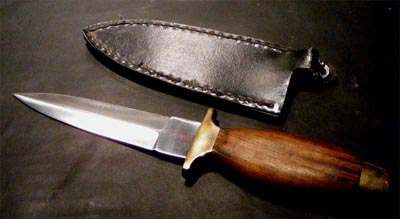
Aussehen
Es gibt keine allgemeingültige bzw. schriftliche Definition, wie ein Athame auszusehen hat.
Grundsätzlich kann man davon ausgehen, dass der Griff des Athames aus Holz und dunkel bis schwarz ist sowie eine zweischneidige, möglichst stumpfe, spitz zulaufende Klinge hat, die aus Metall ist. Der Grund, warum ein dunkler Griff verwendet wird liegt darin, dass dunkle Farben besser Energie speichern können.
In verschiedenen Wicca-Traditionen werden Symbole, die im jeweiligen "Book of Shadows" enthalten sind, in den Griff und in die Klinge eingraviert, eingeätzt oder aufgemalt.
Die Symbole stammen überwiegend aus den verschiedenen Fassungen des Clavicula Salomonis. Einige Autoren (Doreen Valiente, Raven Grimassi etc.) schlagen andere Symbole vor, bleiben aber jedoch eine Erklärung über deren Bedeutung mehr oder minder schuldig.
Gardner verwendete diese Symbole mit folgenden Erklärungen:

Weihe
Nachdem die entsprechenden Symbole angebracht sind, wird das Athame in einem speziellen Ritual geweiht. Hierbei wird das Athame mit der Energie eines bereits geweihten Athames sowie mit männlicher, als auch weiblicher Energie geladen. Danach soll es der Besitzer einen Monat lang Tag und Nacht bei sich tragen. Hierdurch wird es mit dem Besitzer "verbunden".
Nach diesem Monat sollte es entweder auf dem Altar liegend aufgehoben werden oder eingehüllt in einem schwarzen Tuch, damit die Energie, mit der es geladen wurde und die in ihm gespeichert ist, erhalten bleibt.
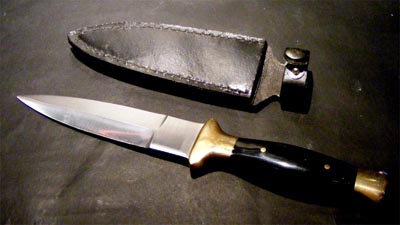
Zuordnung
Das Athame wird mit dem maskulinen Prinzip des Gottes assoziiert. Es ist dem Element Feuer zugeordnet (in anderen Traditionen dem Element Luft).
Die Zuordnung zum Element Feuer ergibt sich aus seiner rituellen Verwandtschaft mit dem Ritualschwert. Ein Symbol, das Gardner auf dem Ritualschwert verwendet, entspricht dem hebräischen Namen des Erzengels Michaels, der wiederum dem Süden und dem Feuer zugeordnet ist.
Verwendung
Die Hauptanwendung des Athames liegt darin, die Energie für den magischen Kreis zu liefern und diesen zu beschreiben, die Elementpentagramme zu ziehen und um Energie zu lenken.
Es wird nicht für Schneidearbeiten verwendet, hierzu dient das Messer mit dem weißen Griff.
Darüber hinaus wird es in dem Ritualteil "Cakes & Wine" eingesetzt. Dies ist eine Segnung des Weins, in dem das Athame in den mit Wein gefüllten Kelch geführt wird, und des Kuchens. Hierbei wird jedes Kuchenstück mit dem Athame berührt. Beide rituellen Akte dienen dazu, die göttliche Energie (des Gottes) durch das Athame auf den Wein bzw. den Kuchen zu übertragen. Die Segnung des Weins stellt keinen symbolischen "Great Rite" dar.
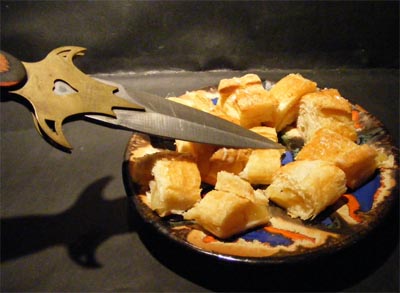
Als eines der acht Arbeitswerkzeuge einer Hexe und als Elementarwaffe kann es auf der astralen Ebene auch als echte Waffe gegen Spirits eingesetzt werden. Mit dem Athame beherrscht man den magischen Kreis.
Sobald der Kreis aufgelöst wird, speichert man die Energie, die während des Rituals nicht verbraucht wurde, im Athame. Dies geschieht durch Visualisierung beim Durchschneiden und Auflösung des Kreises.
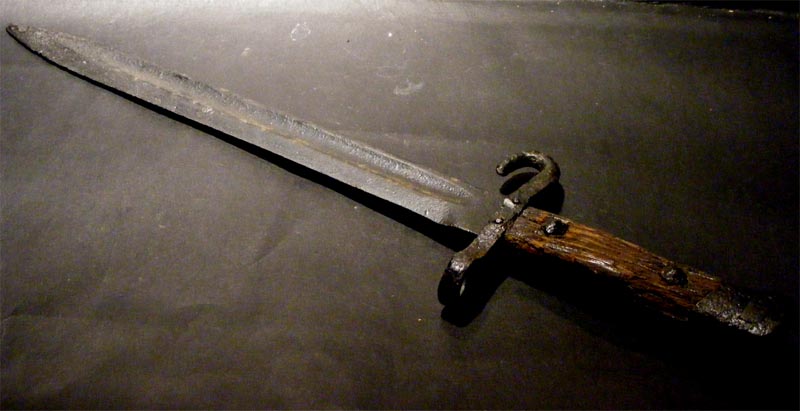
Ein sehr altes "Athame" (Ende des 19. Jahrhundert) aus der Sammlung Gerald B. Gardners, im Besitz des Blue Moon Covens